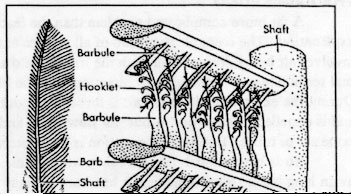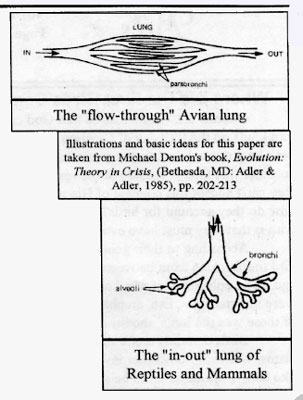Genesis 1:20 & 21 tells us that God created all the bird kinds on the fifth day of Creation Week. But, since God can't be put into laboratory experiments, main-line scientists consider that God is outside of the realm of science, and thus they can't accept this concept of His sudden Creation. So how do they account for birds? The only choice they're left with is that they must have evolved from earlier creatures. According to their geologic time scale, the earliest bird fossils came from between 100 and 200 million years ago. The only kinds of fossil creatures found earlier than that were invertebrates, fish, amphibians, and reptiles. So, which of these was the birds' ancestor? Birds certainly aren't shaped anything like jellyfish, clams, worms, or any other invertebrates, and they don't look like fish. Reptiles seem to be slightly better candidates than amphibians, so they searched for a reptile that had some resemblence to birds. The movie Jurassic Park played up the idea that maybe Oviraptor was the ancestor of birds, and others have suggested the chicken-sized Compsognathus. FEATHERS We've heard much discussion about how the scales of some such dinosaur might have been changed into feathers, as if that would be enough to show descent from dinosaur to bird. But it's hard to see how horny scales, simple plates, could develop the complexity shown in the drawing at upper right. Gerhard Heilman suggested that some reptilian ancestor he called "pro-avis" was a tree-climber, and began jumping and gliding. Friction of the air on the scales caused them to fray, and this supposedly led to development of feathers. J.H. Ostrom suggests that a reptile ran along the ground, and jumped to catch insects with its front feet. The legs flattened and spread to make better "insect nets," then somehow changed into feathered wings. Both of these seem highly speculative, very unlikely, and completely unsupported by evidence. One problem they each failed to address is the cumbersome shape of the intermediate "half-leg-half-wing" stage, and such a continuing gradual improvement with each new generation would have taken thousands of years. Such a half-developed new shape would hinder its original function, while not yet adequate to be efficient in its new use. This would be very disadvantageous to its owner, making it more subject to predators, and giving less chance of favorable natural selection. Look at the intricate structure of the flight feather above. Each feather has a main quill, with many barbs protruding outward at right angles to the quill. Each barb has a series of barbules. Anterior (front) barbules have hooks which lock into ridges on the posterior side of the adjacent barbules -- like a zipper. A set of tendons allows them to flex and rotate, to form tiny slots on an upward wingbeat and impervious airfoil on the downward power stroke. This dramatically improves aerodynamic efficiency, something like a Handley-Page slot reduces turbulence on a modern airplane wing. Can this complex structure, having all of the signs of very intelligent design, have evolved from a "frayed reptilian scale"? Michael Denton quotes Barbara Stahl in Vertebrate History: Problems in Evolution, as saying, "... how they [feathers] arose initially, presumably from reptilian scales, defies analysis." THE AVIAN LUNG  A far more complicated problem than the feather has defied explanation. The respiratory system of all reptiles and mammals involves air being drawn in through the trachea into a series of small tubes that terminate in alveoli, where interaction with the blood takes place. During the expiration phase the air is forced back out through the trachea, and is expelled. This is an "in-out" air flow, back and forth through the same set of tubes. But avian respiration is completely different. A far more complicated problem than the feather has defied explanation. The respiratory system of all reptiles and mammals involves air being drawn in through the trachea into a series of small tubes that terminate in alveoli, where interaction with the blood takes place. During the expiration phase the air is forced back out through the trachea, and is expelled. This is an "in-out" air flow, back and forth through the same set of tubes. But avian respiration is completely different.
Birds have nostrils and a trachea which connects to the lungs. But the avian lung has no alveoli; instead it has a set of many tiny tubes called parabranchi. Air interacts with blood in these parabronchi, bringing in oxygen and removing carbon dioxide and impurities. These merge together at the lung's outlet so as to allow air to eventually exit through the trachea and nostrils. Thus air passes through a bird's lungs in a very efficient continuous "flow-through" manner, not the "in-out" style of all other vertebrates except fish. Bird's lungs are firmly attached to body walls, and can't change size or shape during the breathing cycle. To force air through, there is a system of air-sacs, many of which have muscles arranged to contract and expand in a sequential manner, so that they keep bringing air in, forcing it through the lungs, then forcing it back out of the nostrils again. Several air sacs receive fresh air from the trachea; others are filled with the dirty air after it passes through the parabranchi. Some sacs are distributed through the body; others are in the humerous and other larger hollow bones. Birds have a very high metabolic rate, and thus require a high breathing rate. They also generate a lot of body heat, which must be removed in an efficient manner; they don't have sweat glands. Some of the air sacs seem to accomplish this heat removal function, as well as being an inherent part of respiration. This seems to be part of a temperature-regulating mechanism -- that is, birds are "warm-blooded." This contrasts with reptiles, whose body temperature is taken from their surroundings. This is another characteristic that hasn't been well-described as to a mode of possible evolution. This flow-through lung system, driven by sequential air-sac contractions, is present in all 8600 or so species of birds, from hummingbirds to ostriches to eagles, but only the birds possess it. Can anyone imagine how such a unique system could have evolved gradually, from the totally different reptilian lung, while still maintaining good respiration function? If so, they haven't described it. And there is absolutely no physical evidence of how it could have come about! Charles Darwin wrote, in Origin of Species, "If it could be demonstrated that any complex organ existed which could not possibly have been formed by numerous, successive, slight modifications, my theory would absolutely break down." We've discussed two of several features of birds that have, so far, been impossible to so describe. That looks like enough difficulty to meet Darwin's challenge. If not, why hasn't someone shown how it could have happened? These unique features of birds offer good evidence that the best explanation of the origin of all the birds is that they must have descended from God's original flock of birds. "And God created ... every winged fowl, after his kind: and God saw that it was good. ... And the evening and the morning were the fifth day." (Genesis 1:21, 23) |